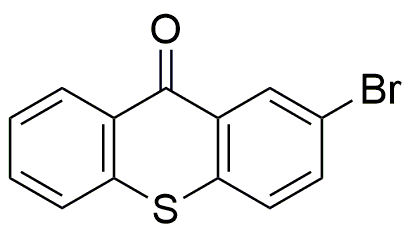2-Bromo-9H-thioxanthen-9-one is widely utilized in research focused on:
- Organic Synthesis: This compound serves as a valuable intermediate in the synthesis of various organic molecules, particularly in the development of dyes and pigments, enhancing color properties in textiles and plastics.
- Photochemical Applications: Its unique structure allows it to be used in photochemical reactions, making it useful in the creation of light-sensitive materials for applications in photography and imaging technologies.
- Biological Research: Researchers employ this compound in studies investigating its potential as a fluorescent probe, aiding in the visualization of biological processes in live cells.
- Pharmaceutical Development: It has shown promise in medicinal chemistry for developing new therapeutic agents, particularly in targeting specific biological pathways, which can lead to more effective treatments.
- Material Science: This chemical is explored for its properties in creating advanced materials, such as conductive polymers, which are essential in electronics and energy storage devices.
Informations générales
Propriétés
Sécurité et réglementation
Applications
2-Bromo-9H-thioxanthen-9-one is widely utilized in research focused on:
- Organic Synthesis: This compound serves as a valuable intermediate in the synthesis of various organic molecules, particularly in the development of dyes and pigments, enhancing color properties in textiles and plastics.
- Photochemical Applications: Its unique structure allows it to be used in photochemical reactions, making it useful in the creation of light-sensitive materials for applications in photography and imaging technologies.
- Biological Research: Researchers employ this compound in studies investigating its potential as a fluorescent probe, aiding in the visualization of biological processes in live cells.
- Pharmaceutical Development: It has shown promise in medicinal chemistry for developing new therapeutic agents, particularly in targeting specific biological pathways, which can lead to more effective treatments.
- Material Science: This chemical is explored for its properties in creating advanced materials, such as conductive polymers, which are essential in electronics and energy storage devices.
Documents
Fiches de données de sécurité (FDS)
La FDS fournit des informations de sécurité complètes sur la manipulation, le stockage et l’élimination du produit.
Spécifications du produit (PS)
Le PS fournit une description complète des propriétés du produit, notamment sa composition chimique, son état physique, sa pureté et les exigences de stockage. Il détaille également les plages de qualité acceptables et les applications prévues du produit.
Certificats d'analyse (COA)
Recherchez des certificats d'analyse (COA) en saisissant le numéro de lot du produit. Les numéros de lot et de lot se trouvent sur l'étiquette d'un produit, après les mots « Lot » ou « Lot de fabrication ».
Numéro de catalogue
Numéro de lot/série
Certificats d'origine (COO)
Ce certificat d'exploitation confirme le pays dans lequel le produit a été fabriqué, et détaille également les matériaux et composants utilisés et s'il est issu de sources naturelles, synthétiques ou autres sources spécifiques. Ce certificat peut être requis pour les douanes, le commerce et la conformité réglementaire.
Numéro de catalogue
Numéro de lot/série
Fiches de données de sécurité (FDS)
La FDS fournit des informations de sécurité complètes sur la manipulation, le stockage et l’élimination du produit.
DownloadSpécifications du produit (PS)
Le PS fournit une description complète des propriétés du produit, notamment sa composition chimique, son état physique, sa pureté et les exigences de stockage. Il détaille également les plages de qualité acceptables et les applications prévues du produit.
DownloadCertificats d'analyse (COA)
Recherchez des certificats d'analyse (COA) en saisissant le numéro de lot du produit. Les numéros de lot et de lot se trouvent sur l'étiquette d'un produit, après les mots « Lot » ou « Lot de fabrication ».
Numéro de catalogue
Numéro de lot/série
Certificats d'origine (COO)
Ce certificat d'exploitation confirme le pays dans lequel le produit a été fabriqué, et détaille également les matériaux et composants utilisés et s'il est issu de sources naturelles, synthétiques ou autres sources spécifiques. Ce certificat peut être requis pour les douanes, le commerce et la conformité réglementaire.


